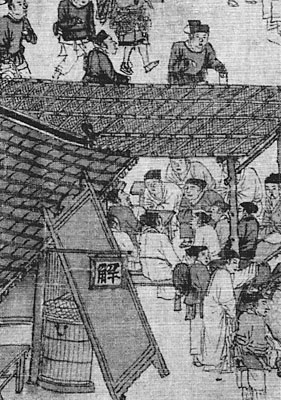A Short Introduction
 From the time of the Song dynasty (960-1279)
historical sources testify not only to the existence, but also to
the popularity of professional storytelling in China. In the
ever-growing urbanizations, the story-teller had become an
established figure of the marketplace and bazaar. This traditional
art has developed and continued into the present, in forms based
primarily on oral transmission. We find a large number of local
varieties of story-telling all over China. The question is whether
these arts will be able to live on into their second millennium,
face to face with the modern media and the modern lifestyle?
From the time of the Song dynasty (960-1279)
historical sources testify not only to the existence, but also to
the popularity of professional storytelling in China. In the
ever-growing urbanizations, the story-teller had become an
established figure of the marketplace and bazaar. This traditional
art has developed and continued into the present, in forms based
primarily on oral transmission. We find a large number of local
varieties of story-telling all over China. The question is whether
these arts will be able to live on into their second millennium,
face to face with the modern media and the modern lifestyle?
On the threshold of the twenty-first century the generation of story-tellers who was born and educated early in the previous century is now in old age. But many of them are still active and are great masters of their traditional art. The life conditions of the storytellers of this century have fluctuated, as the society has gone through times of war and revolution. In recent years they have to face the profound changes in peoples' habits and attitudes, when work and leisure and types of entertainment are so different from earlier times. We cannot at present know if the storytellers' oral art will be able to survive the arrival of the modern media-technology. We think it is high time that the international society takes responsibility to preserve this unique oral art. New media-technology is a threat to the oral arts, but it is also a great advantage for preserving the arts that are still alive today.
In spite of the humble social position of the storytellers, their art always had a heavy impact on the daily life of the Chinese townspeople, serving as the 'university' of ordinary people - the place where culture and knowledge was communicated in an entertaining and simple way. This oral genre played an astonishing part in the formation of the written genres of the novel and short story. Conversely, the historical and fictional genres that were transmitted in written form, influenced the oral genres deeply. The orality/literacy dichotomy, treated in its cultural-specific context, seems of major importance for an understanding of the structural specifics and conditions of existence of the oral arts. The storytelling genres have survived as orally transmitted traditions up to our present time and as such they offer a unique territory for research in oral tradition.